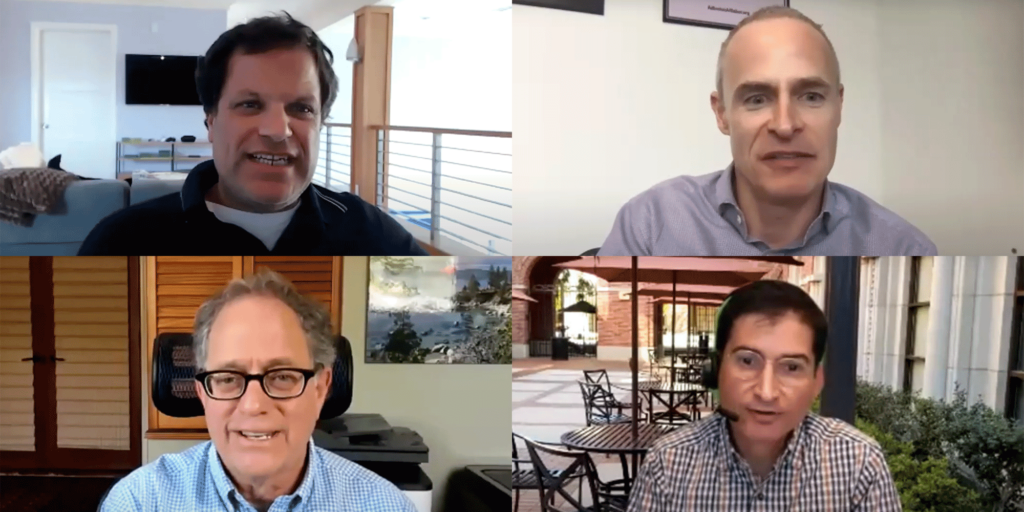In addition to being a public health crisis, the COVID-19 pandemic threatens the world with economic disaster. To address how to mitigate the coronavirus’ rising danger to lives and livelihoods, the USC Schaeffer Center for Health Policy & Economics gathered experts for a widely viewed webinar on April 29.
Moderated by Schaeffer Center Director Dana Goldman, the online forum featured Amgen Senior Vice President Steven Galson, MD, Schaeffer Center Senior Fellow Bob Kocher, MD, and Schaeffer Center Director of Research Darius Lakdawalla. The panelists’ efforts illustrate how industry, government and universities have joined together to combat COVID-19 on all fronts.
The participants all agreed that reliable testing must be widely available before schools and businesses can safely reopen while cures and treatments continue to be sought. The question is: How can tests be performed both accurately and cost effectively?
Containing the Spread
“Control of the first wave will determine the severity of the second,” Kocher said, adding that “testing will be crucial for managing the second wave.”
Kocher, who previously served in the Obama administration, spoke from Sacramento, where he works as part of the California COVID-19 Testing Task Force. Referring to “R0,” a baseline term for estimating the number of people who will contract a contagious disease from each infected person, he noted that “a virus exists to spread itself — and this virus has an R0 of about 2.4.”
He said when comparing Italy and California, social-distancing interventions appear to be working quite well. California had logged nearly 50,000 cases of COVID-19 at the time of webinar. As a result, the R0 in most of the state has been between 1 and 1.3. “We’d be at around 400,000 at this point in time if we hadn’t taken these steps,” he noted.
However, social distancing can only buy so much time in preventing the healthcare system from becoming overloaded. “So we’re working to ramp up testing,” Kocher said of California.
Testing lets us know who is actively spreading the virus. After the virus has been found in a patient, the next essential step is find out who they have been in contact with to administer care and stop continued spread. One bright spot is that this opens up job opportunities for unemployed people. Technology can also aid in contact tracing, for example, using cell phone locations to notify if you’ve potentially been in contact with someone whose infectious.
Therapeutic Development
Despite the optimistic tone of some politicians, vaccine development requires a great deal of time and funding to ensure safety as well as effectiveness. Galson — Amgen senior vice president of Global Regulatory Affairs and Safety and a former acting U.S. surgeon general — discussed his company’s partnerships against COVID-19.
For example, a partnership in Iceland has leveraged that nation’s relative isolation and small population size to conduct a study of the early spread of COVID-19 there. Published in the New England Journal of Medicine, the study provides public health officials with scientific data that can be used for policy decisions as they strategize to mitigate the spread of COVID-19.
Galson said Amgen is also looking at existing therapies to evaluate their viability in combating the virus. This includes antibodies specific to the coronavirus, drugs targeting virus replication and anti-inflammatory agents that may interrupt the effects of COVID-19.
Amgen also engages with the National Institutes of Health and companies around the world in seeking possible treatments. One consortium, COVID R&D, is “testing multiple therapies together to reduce time, improve efficiency — and make sure that physicians don’t have to deal with a thousand different entities,” Galson said.
The Potential of Pooled Testing
Lakdawalla discussed the potential advantages of pooled testing, which is the subject of a forthcoming white paper he cowrote with Goldman, USC Schaeffer Associate Director Erin Trish and Emmett Keeler of the RAND Corporation. Instead of running tests on each individual in a company or school, pooled testing processes their samples in batches.
“Given the current prevalence of COVID-19, even 5 person pools of employees or students are likely to test negative, obviating the need for administering tests to each person,” Lakdawalla said.
The co-authors’ analysis shows the approach could reduce testing costs by at least half — adding up to tens of billions of dollars in savings. This would remain true even when some people test false-positive or false-negative. “One solution to imperfect tests is that you can afford to do an additional round of follow-up testing, because you’re saving a considerable amount of money by reducing the overall number,” he noted.
One caveat is that understanding the coronavirus’ prevalence in a particular group is vital to picking the right pool size. If prevalence is high and the pools are too big, the tests will quickly eat up any cost savings. On the other hand, if pools are small, employers will not fully benefit from the strategy’s potential. Generally, the researchers found a pool size of four to be an optimal number.
“Pool testing — which has already been used to some extent in monitoring COVID-19 — might be one component in a strategy for national testing, contact tracing, and reopening workplaces and universities,” Lakdawalla said.
More Answers Needed
In conclusion, Goldman asked each panelist to name which question he felt was most urgently in need of answers to better inform policymaking or research aimed at reducing the coronavirus’ dangers until viable treatments are found.
“I badly want to expand what we know about immunity and protection for those who have been exposed, and how long that lasts,” Kocher said.
Galson responded that he wanted to know exactly how infectious asymptomatic people are, “and whether they’re less infectious than those who are symptomatic.”
Lakdawalla expressed the importance of knowing how many people with COVID-19 are asymptomatic. “I think taken together,” he said of the questions posed, “we’ll get a pretty good sweep of everything we need to know.”
